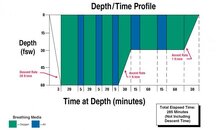I have long had a question that I finally asked at the tail end of a long thread, and I decided I would ask it again in this forum where it can get the attention of knowledgeable medical minds.
When a friend of mine got bent and had to go through a serious of hyperbaric treatments, he was never alone in the chamber. Others were getting treatments as well, but none of them were being treated for anything related to diving. In fact, many hospitals with hyperbaric chambers will not treat DCS victims, reserving their use for patients with a wide variety of other ailments. When he played with the Denver Broncos, linebacker Bill Romanowski owned his own chamber and used it to speed recovery after every game. Here are some highly reputable medical web sites describing the benefits to the healing body of hyperbaric oxygen therapy (HBOT):
Hyperbaric oxygen therapy - Mayo Clinic
https://www.nlm.nih.gov/medlineplus/ency/article/002375.htm
Medscape: Medscape Access
Hyperbaric Oxygen Therapy for Wound Healing | Johns Hopkins Medicine Health Library
So there does not seem to be any question that HBOT provides great benefits to bodies healing from a wide variety of ailments. In contrast, conventional thinking is that breathing elevated levels of oxygen by diving with nitrox provides no such benefit whatsoever. Can anyone explain why inhaling elevated oxygen under pressure has such well proven benefits when done in a hyperbaric chamber, yet it has no such effect when done under water?
When a friend of mine got bent and had to go through a serious of hyperbaric treatments, he was never alone in the chamber. Others were getting treatments as well, but none of them were being treated for anything related to diving. In fact, many hospitals with hyperbaric chambers will not treat DCS victims, reserving their use for patients with a wide variety of other ailments. When he played with the Denver Broncos, linebacker Bill Romanowski owned his own chamber and used it to speed recovery after every game. Here are some highly reputable medical web sites describing the benefits to the healing body of hyperbaric oxygen therapy (HBOT):
Hyperbaric oxygen therapy - Mayo Clinic
https://www.nlm.nih.gov/medlineplus/ency/article/002375.htm
Medscape: Medscape Access
Hyperbaric Oxygen Therapy for Wound Healing | Johns Hopkins Medicine Health Library
So there does not seem to be any question that HBOT provides great benefits to bodies healing from a wide variety of ailments. In contrast, conventional thinking is that breathing elevated levels of oxygen by diving with nitrox provides no such benefit whatsoever. Can anyone explain why inhaling elevated oxygen under pressure has such well proven benefits when done in a hyperbaric chamber, yet it has no such effect when done under water?





